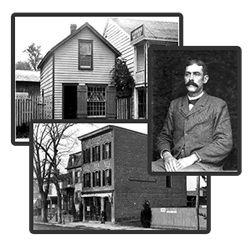
|
The Piersaull Collection consists of 379 glass plate negatives taken by Hyde Park resident Charles Sylvester Piersaull between the years 1890 and 1900. Mr. Piersaull's photographed the people, buildings, and landscape of Hyde Park, giving us a unique look into life in turn-of-the-century Hyde Park, New York. The negatives were found by Celia Zepf while cleaning out the basement of one of her father Albert's buildings. She turned the photographs over to the National Park Service headquarters at Vanderbilt Mansion so that they could be held at the Library of Congress, but when Franklin Roosevelt learned of the photographs, he insisted they be held at his library. "There is no question," he wrote to National Park Service, "that the negatives and other material relating to Hyde Park and Dutchess County should be deposited in the Franklin D. Roosevelt Library." FDR wanted his local history to be enjoyed and studied by Hyde Park residents. Townspeople helped to identify the photographs and on January 23, 1943, the negatives were turned over to the FDR Library. |
|
|
 Why Does the FDR Library Have These Pictures?
Why Does the FDR Library Have These Pictures?
